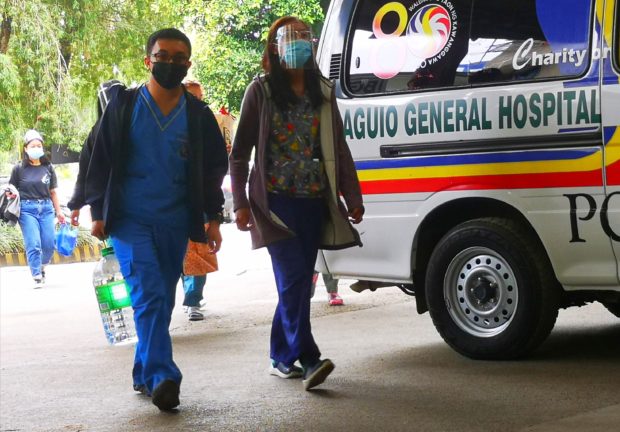
REPORTING FOR DUTY Nurses report for their shift at Baguio General Hospital and Medical Center in Baguio City, the primary treatment facility for Covid-19 in the summer capital. —EV ESPIRITU
MANILA, Philippines — The use of health-care facilities in Davao de Oro province and Baguio City has reached a critical level as the Department of Health (DOH) and local governments confront the rising number of new coronavirus disease (Covid-19) cases in the country, according to Health Secretary Francisco Duque III.
Duque also noted the high health-care utilization rates in Nueva Vizcaya and Agusan del Norte provinces.
Health-care utilization rate is one of the factors that officials consider when determining the quarantine levels for specific areas. It refers to the number of intensive care units, isolation beds and ventilators currently in use in a locality’s hospitals and medical facilities.
Coordination
The Inter-Agency Task Force for the Management of Emerging Infectious Diseases was set to meet on Tuesday to recommend quarantine classifications for February.“We continue to coordinate with our [DOH] Centers for Health Development, the [Department of the Interior and Local Government] and [local governments] to stop the continued rise of cases though our [prevent-detect-isolate-treat-reintegrate] strategies, especially through compliance with minimum public health standards,” Duque said in a meeting in Malacañang on Monday.
On Tuesday, presidential spokesperson Harry Roque said Covid-19 cases in the country had risen in the past three days, probably due to the surge caused by holiday activities.
Situation in Metro, regions
“There has been a notable increase in trend in the first two weeks of January, with cases coming in from other regions,” Roque said at a press briefing.
The spikes were reported in Metro Manila, Ilocos, Cagayan Valley, Central Luzon, Calabarzon, Central Visayas, Eastern Visayas, Zamboanga Peninsula, Northern Mindanao, Davao and Caraga regions.
Based on the two-week growth rate, considered high risk are the provinces of Kalinga, Mountain Province, Aurora, Ifugao, Catanduanes, Apayao, Basilan, Antique, Romblon, Masbate, Bukidnon, Davao Occidental, Abra, Davao de Oro, Cebu and Sulu, and the cities of Cebu and Mandaue.
Considered high risk based on the average daily attack rate are Kalinga, Mountain Province, Baguio, Benguet and Dagupan City.
Mask up
Roque said the country’s bed capacity for Covid-19 patients was adequate, pointing out that 25 percent of hospital beds had been allocated for them.
The utilization rate of temporary treatment and monitoring centers is also far from reaching moderate level, he said. It is at the regional health-care utilization rate where there are areas at critical and high levels, as Duque reported, Roque said.
President Duterte, during Monday’s meeting, stressed the need for Filipinos to comply with health protocols to protect themselves from being infected. He called out those who wear their masks improperly by not letting these cover their noses.
Masks may not offer full protection, but these will reduce the chance of people catching the virus, Mr. Duterte said.
Hospitals full
In Baguio, two hospitals already reached full capacity last week as the number of patients seeking treatment for Covid-19 continued to grow.
Baguio General Hospital and Medical Center (BGHMC) and Notre Dame de Chartres Hospital (NDCH) have limited admissions as their maximum bed capacities.
In an advisory on Jan. 22, the government-run BGHMC, which serves as the primary COVID-19 facility in the city, said the number of severe to critical cases were being treated there. The hospital also suspended nonemergency surgery admissions.
The management of NDCH, a private hospital, said it could no longer accommodate probable and confirmed Covid-19 patients.
As of Jan. 25, Baguio had recorded 4,821 Covid-19 cases, 565 of which remained active. INQ